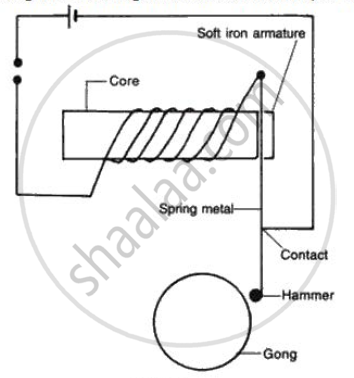Advertisements
Advertisements
प्रश्न
What do you understand by ‘earthing’? What are the advantages of earthing in a household electric circuit? Explain, how it is done?
उत्तर
By earthing we mean that the metallic body of an electric appliance is connected to thick copper wire, which is buried deep in the earth and at its end is a copper plate surrounded by a mixture of charcoal and common salt.
Advantages: It is a kind of safety device which saves us from an electric shock, in a case when the
the metal casing of the appliance happens to touch the live wire or due to short-circuiting or leakage of electric current.
Whenever an appliance which is earthed, get short-circuited, the current from the metal casing of the appliance flows into the earth which acts as an ‘electric sink’, i.e., its potential always remains zero. Due to the flow of heavy current, the fuse in that circuit melts and disconnects the appliance from the circuit.
So the user who happens to touch the appliance is protected from receiving any electric shock. Another advantage is that overheating the house wiring system is saved from being damaged and the same time from being burnt out.
Procedure: A three core, cord having three wires coated with insulation of red, brown, and green colour, is used for connecting die appliance to the mains for drawing current from the mains. At one end of the cord, red is connected to the pin marked L (live), the brown to the pin marked N (neutral) and green to a thick pin of the plug. The three wires at the other end of the cord are connected to the appliance such that live and neutral wires are connected to the element and the earth wire is connected to the metal body of the appliance so as to earth it.
Once the plug is put in the socket, the current through the appliance becomes as soon as the switch is pressed. The live wire gets connected to the live wire of the mains. Neutral wire is connected to the neutral of the mains and the earth wire gets connected to the earth in the mains.
APPEARS IN
संबंधित प्रश्न
Which uses more energy : a 250 W TV set in 1 hour or a 1200 W toaster in 10 minutes?
In a filament type light bulb, most of the electric power consumed appears as:
(a) visible light
(b) infra-red-rays
(c) ultraviolet rays
(d) fluorescent light
Fig . shows the essent ial features of a battery operated bell. The hammer strikes the gong when the swi tch is closed . State and explain the effect of using the following material successively to form the core.

(a) Plastic
(b) Steel
(c) Copper
Two resistors A and B of 4 Ω and 6 Ω, respectively are connected in parallel. The combination is connected across a 6 volt battery of negligible resistance. Calculate the power dissipated in each resistor.
Define electric power. An electrical device of resistance R is connected across a source of voltage V and draws a current I. Derive an expression for power in terms of current and resistance.
In an electric radiator or room heater, state with reason, why the porcelain tube wound with a nichrome wire is placed between the pole and principal focus of the parabolic concave reflector.
Why is a concave reflector placed behind the heating element in a room heater.
An electric bulb is rated as 100W – 250V. What information does it convey? Calculate the resistance of its filament while glowing.
An Electric bulb is marked 100 W, 230 V. What current does it take?
